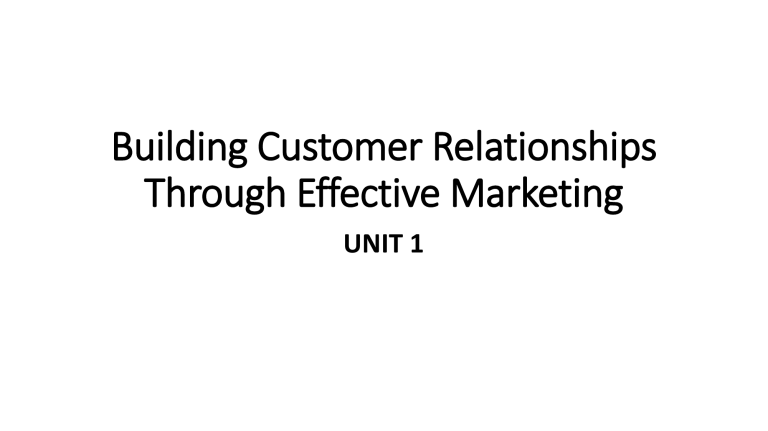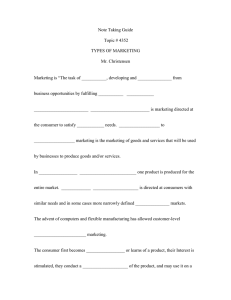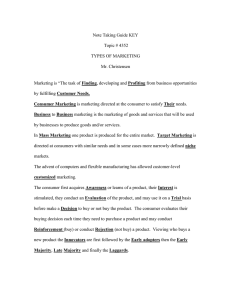
Building Customer Relationships Through Effective Marketing UNIT 1 LEARNING OBJECTIVES 1. Understand the meaning of marketing and the importance of management of customer relationships. 2. Explain how marketing adds value by creating several forms of utility. 3. Trace the development of the marketing concept and understand how it is implemented. 4. Understand what markets are and how they are classified. 5. Identify the four elements of the marketing mix and be aware of their importance in developing a marketing strategy. 6. Explain how the marketing environment affects strategic market planning. 7. Understand the major components of a marketing plan. 8. Describe how market measurement and sales forecasting are used. 9. Distinguish between a marketing information system and marketing research. 10. Identify the major steps in the consumer buying decision process and the sets of factors that may influence this process. Marketing and the importance of customer relationships. • Marketing is an organizational function and a set of processes for creating, communicating, and delivering value to customers and for managing customer relationships in ways that benefit the organization and its stakeholders. • Maintaining positive relationships with customers is crucial. Relationship marketing is establishing long-term, mutually satisfying buyer-seller relationships. • Customer relationship management uses information about customer to create marketing strategies that develop and sustain desirable customer relationships. • Managing customer relationships requires identifying patterns of buying behavior and focusing on the most profitable customers. • The customer lifetime value is a combination of purchase frequency, average value of purchases, and brand-switching patterns over the entire span of the customer's relationship with the company. How Marketing adds Value • Marketing adds value in the form of utility or the power of a product or service to satisfy a need. • It creates utility by making products available where customers want them, time utility by making products available when customers want them, and possession utility by transferring the ownership of products to buyers. The Marketing Concept and it’s implementation • From the Industrial Revolution until the early twentieth century, business people focused on the production of goods; from the 1920s to the 1950s, the emphasis moved to the selling of goods. • During the 1950s, however, business people recognized that their enterprises involved not only producing and selling products but also satisfying customers' needs. • They began to implement the marketing concept, a business philosophy that involves the entire organization in the dual processes of meeting the customers' needs and achieving the organization's goals. • Implementation of the marketing concept begins and ends with customers - first to determine what customers' needs are and later to evaluate how well the firm is meeting those needs. Markets and their Classification • A market consists of people with needs, the ability to buy, and the desire and authority to purchase. • Markets are classified as consumer and industrial (producer, reseller, governmental, and institutional) markets. Elements of the Marketing Mix and its importance in developing a marketing strategy • A marketing strategy is a plan for the best use of an organization's resources to meet its objectives. • Developing a marketing strategy involves selecting and analyzing a target market and creating and maintaining a marketing mix that will satisfy that target market. • A target market is chosen through either the undifferentiated approach or the market segmentation approach. • A market segment is a group of individuals or organizations within a market that have similar characteristics and needs. • Businesses that use an undifferentiated approach design a single marketing mix and direct it at the entire market for a particular product. • The market segmentation approach directs a marketing mix at a segment of a market. • The four elements of a firm's marketing mix are product, price, distribution, and promotion. • The product ingredient includes decisions about the product's design, brand name, packaging, and warranties. • The pricing ingredient is concerned with both base prices and various types of discounts. • Distribution involves not only transportation and storage but also the selection of intermediaries. • Promotion focuses on providing information to target markets. • The elements of the marketing mix can be varied to suit broad organizational goals, marketing objectives, and target markets. How the Marketing Environment affects Strategic Market Planning • To achieve a firm's marketing objectives, marketing mix strategies must begin with an assessment of the marketing environment, which in turn will influence decisions about marketing mix ingredients. • Marketing activities are affected by a number of external forces that make up the marketing environment. • These forces include economic forces, sociocultural forces, political forces, competitive forces, legal and regulatory forces, and technological forces. • Economic forces affect customers' ability and willingness to buy. • Sociocultural forces are societal and cultural factors, such as attitudes, beliefs, and lifestyles, that affect customers' buying choices. • Political forces and legal and regulatory forces influence marketing planning through laws that protect consumers and regulate competition. • Competitive forces are the actions of competitors who are implementing their own marketing plans. • Technological forces can create new marketing opportunities or quickly cause a product to become obsolete. Components of a Marketing Plan • A marketing plan is a written document that specifies an organization's resources, objectives, strategy, and implementation and control efforts to be used in marketing a specific product or product group. • The marketing plan describes a firm's current position, establishes marketing objectives, and specifies the methods the organization will use to achieve these objectives. • Marketing plans can be short-range, covering one year or less; medium-range, covering two to five years; and long-range, covering periods of more than five years. Market Measurement and Sales Forecasting • Market measurement and sales forecasting are used to estimate sales potential and predict product sales in specific market segments. Marketing Information System and Marketing Research • Strategies are monitored and evaluated through marketing research and the marketing information system that stores and processes internal and external data in a form that aids marketing decision making. • A marketing information system is a system for managing marketing information that is gathered continually from internal and external sources. • Marketing research is the process of systematically gathering, recording, and analyzing data concerning a particular marketing problem. • It is an intermittent, rather than a continual, source of marketing information. • Technology is making information for marketing decisions more accessible. • Electronic communication tools can be very useful for accumulating accurate information with minimal customer interaction. • Information technologies that are changing the way marketers obtain and use information are databases, online information services, and the Internet. Consumer Buying Decision Process • Buying behavior consists of the decisions and actions of people involved in buying and using products. • Consumer buying behavior refers to the purchase of products for personal or household use. • Organizational buying behavior is the purchase of products by producers, resellers, governments, and institutions. • Understanding buying behavior helps marketers predict how buyers will respond to marketing strategies. • The consumer buying decision process consists of five steps, including recognizing the problem, searching for information, evaluating alternatives, purchasing, and evaluating after purchase. • Factors affecting the consumer buying decision process fall into three categories: situational influences, psychological influences, and social influences.





